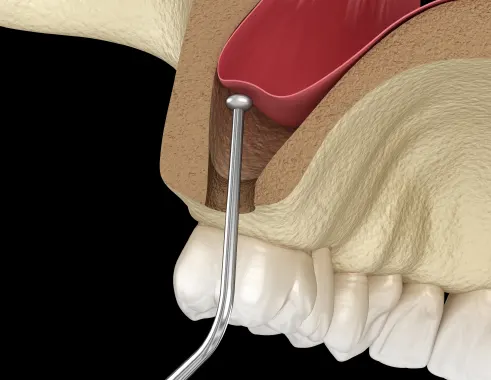
Bone grafting involves taking a sample of bone tissue from you or from someone who is a donor, and transforming it into tiny grains that can be installed in the jaw. The grains of jawbone would then get emplaced in your jawbone where bone loss has occurred, and allowed to heal. Once healed, the grains of jawbone will fuse to your surrounding bone tissue and restore the volume to adequate levels.
To ensure optimal healing, Dr. Moeti performs most bone grafting procedures using a process which is referred to as guided tissue regeneration (GTR). The GTR process serves to protect and maintain the grafted bone as healing occurs, with a mesh-like material providing protection. The point of this is to avoid having gum tissue interfere with the bone graft, as well as to allow healing.

Bone grafting is sometimes needed in order to augment the mass of the jawbone you have, so that it can properly accept a dental implant and support it in your mouth. This kind of jawbone reinforcement is often necessary because people may not immediately undertake a tooth replacement procedure, and that allows time for the jawbone to begin to deteriorate. The jawbone serves to anchor teeth into your mouth, and it stays healthy by constantly using it for chewing and biting.
After a tooth is lost due to severe decay or some kind of trauma, there are no longer any tooth roots in the jawbone to help stimulate it and keep it healthy. That means your body will stop sending resources to that area, and that's what causes the jawbone to gradually deteriorate. The longer that you allow a missing tooth to go untreated, the more likely it is that you will begin to lose jawbone tissue, and that can affect the rest of your teeth as well.
It's also possible you can develop periodontal disease or gum disease, and that causes support to weaken for your natural teeth, and for your jawbone. Some dental plaque is able to work its way below the gum line and start to deteriorate your teeth, and that will also cause you to have a loss of jawbone. People who have worn conventional dentures are also prone to have loss of jawbone, because there is no stimulation to the jawbone itself when dentures merely sit on top of the gum line, offering no stimulation to the jawbone. All of these situations will cause a gradual deterioration of the jawbone, and may require some kind of bone grafting procedure before dental implants can be undertaken.








Request Appointment